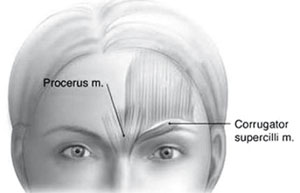Tables 5.1, 5.2, and 5.3 and Figs. 5.3 and 5.4 depict the muscles involved in treatment with botulinum toxin [13].
| | Fig. 5.3. Illustration of upper facial muscles involved in the expression of frowning | | | | | Fig. 5.4. Anatomic consideration of the face for the treatment with botulinum toxin A | |
| | | | | | Table 5.1. Anatomic considerations: upper face | | Muscle | | Function | | | Frontalis | | Raises the eyebrows and produces transverse wrinkles of the forehead | | | Corrugator | | Brings the eyebrows toward each other | | | Procerus | | Pulls the glabellar skin in an inferior direction and causes a transverse rhytid | | | Depressor supercilii | | Depresses the eyebrow | | | Orbicularis oculi | | Functions as the sphincter of the eye | | | | | | | |
| | | | | | Table 5.2. Anatomic considerations: mid and lower face | | Muscle | | Function | | | Risorius | | Draws the corners of the mouth laterally | | | Orbicularis oris | | Sphincter of the mouth | | | Levator labii superioris | | Raises the upper lip | | | Depressor anguli oris | | Depresses the corner of the mouth | | | Depressor labii inferioris | | Lowers the lower lip | | | Modiolus | | Wagon wheel of muscle situated just lateral to the external commissure of the mouth; the muscles of perioral and lip expression insert into here, allowing graded symmetrical perioral expression | | | | | | | |
| | | | | | Table 5.3. Anatomic considerations: neck | | Muscle | Function | | | Platysma | Lowers the jaw and lip; tenses the neck; forms vertical bands and causes horizontal lines | | | | | | | |
